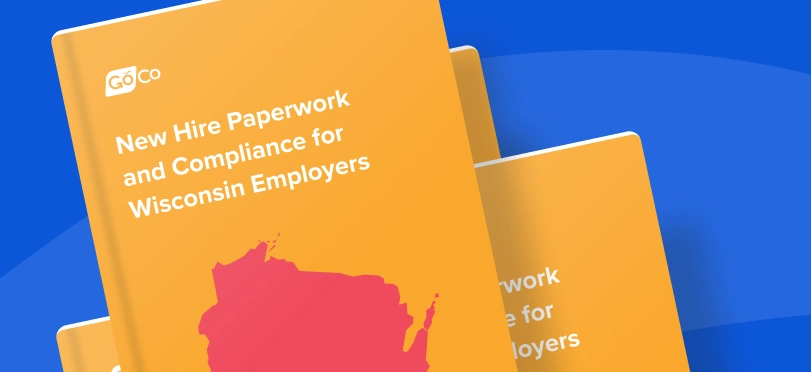New Hire Paperwork and Compliance for Wisconsin
This guide will show you how to navigate Wisconsin's employment laws and procedures and covers everything from the basics of new hire paperwork to compliance laws.
August 18th, 2023
You might have heard the statistics. On average, it costs about $1,500 to onboard a new hire – so it pays to do it right. Organizations with strong onboarding processes improve productivity by 70%. However, it can be confusing and time-consuming, even if you want to invest in great onboarding policies.
As a Wisconsin employer, are you tangled in the extensive web of employee paperwork and compliance requirements? The constant evolution of regulations can be a tough ride, but having a well-structured onboarding system can ease the process.
If you're unsure where to start, start here with this guide. We'll teach you how to navigate the unique landscape of Wisconsin's employment laws and procedures and cover everything from the basics of new hire paperwork in Wisconsin to the diverse compliance laws.
Table of Contents
Benefits of an Effective Hiring and Onboarding Process in Wisconsin
An effective hiring and onboarding process in Wisconsin is essential for businesses to succeed. Not only does it ensure compliance with state regulations, but it also benefits both the employer and the employee.
For example, effective hiring and onboarding processes help:
Increase productivity
Reduce turnover rates
Improve employee morale
By providing clear job expectations, training, and support, employees feel invested in their roles. This, in turn, leads to increased job satisfaction, which can lead to higher levels of:
Engagement
Retention
Productivity
Additionally, you want to comply with Wisconsin state regulations. After all, failure to comply with these regulations can result in financial penalties and legal consequences.
For example, businesses must provide a mandatory pamphlet to new hires. It must inform them of their rights and responsibilities and comply with Wisconsin's unemployment insurance requirements. This kind of compliance paperwork may seem like a hassle, but it's critical you get it right.
Download The Ultimate Onboarding Checklist
New Hire Paperwork in Wisconsin
Wisconsin's basic new hire paperwork is similar to other states. This includes federal forms such as:
I-9
W-4
However, you can also supply your new hires with form WT-4. It's the Employee's Wisconsin Withholding Exemption Certificate/New Hire Reporting form. Depending on your hiring and business compliance needs, you can browse other Wisconsin withholding tax forms.
At a state level, you're required by both federal and state law to report any newly hired employees to the State Directory of New Hires within 20 days. This applies to all Wisconsin employers and labor organizations with a FEIN.
But it's not just new hires that you need to report. Employers also have to report employees they rehire after a separation of 60 days or more. The reasoning behind this? It helps support the state's efforts to ensure that parents receive the child support they're owed.
In addition to reporting requirements, there are other new hire paperwork requirements that employers must meet in Wisconsin. These include, as mentioned above:
Completing the I-9 form to verify the employee's identity and eligibility to work in the US
Providing employees with a copy of the employer's Workers' Compensation insurance policy
Providing employees with a copy of the Wisconsin Fair Employment Law poster/pamphlet
Additionally, in the State of Wisconsin, you must notify new hires of your company's grooming and dress requirements. Aside from that, you'll need to provide employees with standard employee onboarding paperwork. Or, you can give them an employee handbook (in which you can talk about grooming and dress requirements).
What to Include in an Employee Handbook
An employee handbook outlines your company's policies and procedures, providing clear employee expectations. The first thing to include in an employee handbook is information about your company, such as its:
History
Mission statement
Business goals
This helps new employees understand your business and what it stands for. As mentioned above, you should include job-related policies and procedures, like attendance, dress code, and safety guidelines.
Another crucial part of onboarding is completing the necessary paperwork. You'll need to supply new employees with payroll, benefits, and taxes paperwork. This paperwork includes W-4 forms and I-9 forms mentioned above that are legally required. However, it also includes payroll forms like direct deposit authorizations.
In addition to including policies and paperwork, you should educate new employees about your company culture. Tell them about your values, expectations, and goals. This helps them understand how their work impacts the company's success, which can motivate them to do their best work.
Overall, an employee handbook is the backbone of any successful onboarding process. It sets expectations, helps new employees understand your company, and ensures you gather all necessary paperwork.
Wisconsin Payroll & Tax Reporting Requirements
Wisconsin has a graduated individual income tax. Therefore, you must collect form WT-4 and submit it to the state. The form is called Employee's Wisconsin Withholding Exemption Certificate/New Hire Reporting form. Other information you might need to collect for payroll and tax reporting includes the following:
Federal income tax withholding information
Social Security & Medicare
Unemployment insurance information
Additionally, in Wisconsin, you must have workers' compensation insurance if you employ three or more full-time or part-time employees. Or, if you, according to the Department of Workforce Development, "employ one or more full-time or part-time employees to whom you have paid combined gross wages of $500 or more in any calendar quarter for work done at one or more locations in Wisconsin."
HR Duties: Navigating the Onboarding Process
The onboarding process isn't just about collecting the right new hire paperwork in Wisconsin. As an HR professional, planning well before an employee's start date is essential to ensure a smooth and effective onboarding process. Here are some steps that can help you navigate the onboarding process successfully.
Set Up Payroll
One of the first things an HR professional needs to do for a new hire is set up payroll. This includes getting the new employee's details for taxation purposes. However, it also includes ensuring they're properly classified as employees. Ultimately, the goal is to ensure each new employee gets paid on time. This usually includes setting up tax withholdings and choosing a payment method.
New Hire Packet
The next step is to prepare a new hire packet that includes all the necessary paperwork, such as:
Tax forms
Benefits enrollment
Employment agreements
This packet should also include information about your organization's policies, procedures, and culture. The new hire packet can be an overwhelming amount of information, so HR professionals must break it down into digestible parts. Give new employees ample time to complete each section.
Access Cards & Logins
Ensure new hires receive all the required access cards and logins for accessing company systems, buildings, and facilities. By having a plan that includes detailed instructions on using these systems, HR can ensure that new hires are productive from day one.
Meet the Mentor
Having a mentor allows new employees to learn from someone familiar with your organization's policies and culture. HR professionals should identify mentors with the necessary skills and knowledge to support new employees throughout onboarding.
What should they be focusing on? Mentors can help new hires acclimate to their new work environment. Their goal should be to provide insight into the organization's culture, helping new hires feel welcome and supported.
Office Tour
Showing new employees around the office can help them feel comfortable and understand the work environment and culture. By thoroughly explaining the tools and facilities available, you'll help new hires integrate more quickly and feel at home in their new environment.
Frequent Check-Ins
Finally, don't forget to check in with your new hires. These types of check-ins provide new hires with an opportunity to provide feedback and ask questions. You can address issues or concerns by consistently checking in before they become major problems.
A bonus? These check-ins also allow HR professionals to evaluate the effectiveness of the onboarding process and make changes as needed.
Employment Laws in Wisconsin
One of the most basic laws that businesses need to comply with is the Wisconsin Fair Employment Law, which prohibits employers from discriminating against their employees based on their:
Age
Race
Sex
Religion
Disability
National origin
This law also protects against retaliation for employees who file a complaint regarding discrimination or harassment in the workplace.
Wisconsin also has a Minimum Wage Law establishing a minimum hourly wage rate for most workers. Currently, the state minimum wage is $7.25 per hour. Other laws apply depending on your business and industry. They might include:
Bone Marrow and Organ Donation
Cessation of Health Care Benefits Law
Employment of Minors
Employer Retaliation Against Workers
Fair Employment
Family and Medical Leave Law
Meal Periods
Overall, understanding and complying with employment laws in Wisconsin can help you create a fair, safe, and productive work environment for your employees.
How GoCo Supports Wisconsin Employers
Having trouble keeping up with new hire paperwork in Wisconsin? Try GoCo. We're a one-stop shop for all your HR automation needs. With our easy-to-use tools, you can stay up-to-date with evolving legal requirements, simplify your paperwork, and ensure compliance from day one.
Our customizable Magic Docs feature lets you create your policies and track their progress in real-time, so you can say goodbye to endless emails and spreadsheets and automate your tasks with our intelligent onboarding workflow. Save time, avoid missed deadlines, and eliminate costly penalties with GoCo. Take a tour of GoCo today and learn how you can experience a stress-free hiring process.

Subscribe to Beyond The Desk to get insights, important dates, and a healthy dose of HR fun straight to your inbox.
Subscribe hereRecommended Posts
New Hire Paperwork & Onboarding Forms 2025
Blog Articles
Search...
Product
GoCo
Resources
Articles
eBooks
Webinars
Customer Stories






